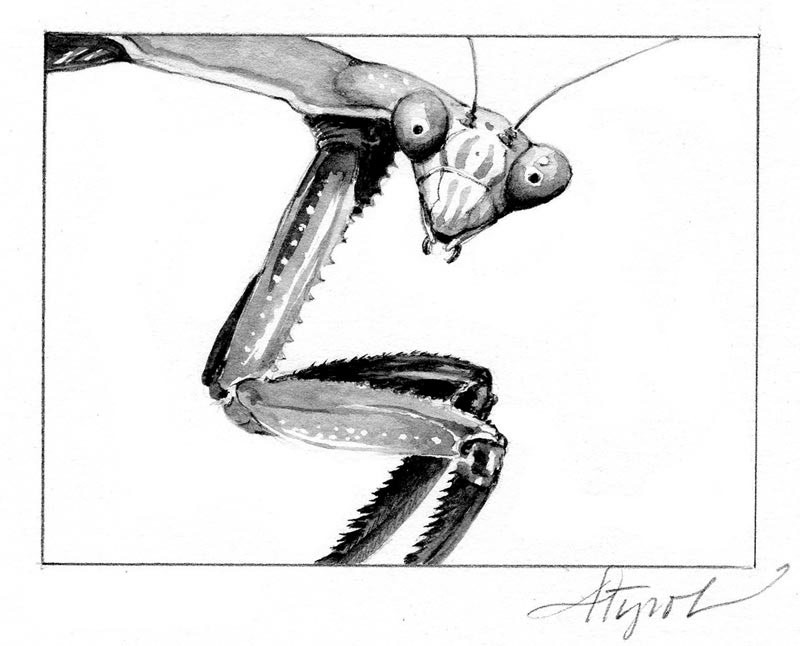
If you’ve been to camp or a business seminar recently, you may have played an icebreaker called “Two Truths and a Lie.” The rules are simple: tell two truths and one lie about yourself and everyone guesses which is which. If insects could play, a praying mantis might fool the group by saying, “I’m a beneficial insect, I’m the only one of my kind in Vermont and New Hampshire, and I’m not native to North America.”
Can you pick out the lie?
The part about being one of a kind in Vermont and New Hampshire is a truth. The animal’s scientific name is Mantis religiosa, and its common name is praying mantis, though just about every one of the 20 or so mantis species that live in the United States are called praying mantis, because they all have “praying” front legs. It’s sort of like calling every kind of soda a Coke.
“It would be even better to call our mantis the European mantis,” said Don Chandler, professor of zoology at the University of New Hampshire and curator of its insect collection.
The species is native to Europe, Chandler explained, but has been found in the wild in this country – particularly in the northeastern U.S. – for over 100 years. Gardeners likely introduced it on purpose. Vermont and New Hampshire are at the northern edge of the praying mantis’ range. “People have tried to introduce it to Canada,” Chandler said, and it is found in southern Ontario and southern Quebec.
While the praying mantis is found in Vermont and New Hampshire, it isn’t found here often. Alan Graham, an entomologist with the Vermont Agency of Agriculture, has lived in Vermont for 20 years, but has only seen six or seven praying mantises in that time.
If you would like to see a praying mantis, this is the best time to look. In the spring, they hatch from egg cases that look like Styrofoam, emerging as tiny versions of their adult selves. They grow throughout the summer until they are two to three inches long.
There are other, sometimes larger, mantis species that are native to other parts of the country, such as the Carolina mantis, which is found as far north as New Jersey. Another introduced species, the Chinese mantis, survives in the wild as far north as southern New England, and at about four inches is the largest mantis species in North America.
“The best place to find praying mantises is in disturbed areas with lots of weeds,” Chandler said. Vacant lots, roadsides, and the edges of parking lots and parks are places to look.
But while searching for praying mantises, don’t be fooled by the mantis fly (a.k.a. mantidfly). These insects are neither mantises nor flies, but members of the same insect order as lacewings and ant lions. Mantis flies have “raptorial” front legs that look just like the praying front legs of a praying mantis.
“The legs developed differently, but they look similar,” said Chandler. There are three species of mantis flies in New Hampshire, he said – one is common, the other two are rare.
In other parts of the world, mantis species may be confused with stick insects (a.k.a. walking sticks). Both types of insects are large, slim, and masters at camouflaging themselves as twigs or leaves. New Hampshire is home to just one species of stick insect, the northern (or common) walkingstick, but it doesn’t look much like a praying mantis.
If a stick insect, which is an herbivore (or vegetarian), encountered a praying mantis, it should watch out. Praying mantises will eat anything they can catch, even if it is their own size, and that means they eat each other, too.
That ferocious and general appetite is what makes them a “neutral,” rather than a beneficial predator of insects – the lie in our game. “They are as likely to eat a honeybee, which we consider good, as a grasshopper, which we consider bad,” Chandler explained.
Asian ladybugs, which were imported to North America to rid gardens of pests (much like the praying mantis was) have turned out to be pests, spoiling wine by getting mixed in with grapes , displacing native ladybugs, and invading houses. But the praying mantis is not as hardy as the Asian ladybug, so there are not enough of them to have a negative impact on the environment, Chandler said.
Because praying mantises quite happily eat each other, Graham noted, they are unlikely to become over-abundant.
At least one biological control company gives the news to its customers straight. Its website reads, “Please note: Praying mantises are cool, but as biocontrols they are not very effective. Order them as a showy novelty, symbol, or pet, but not for pest control purposes.” That, at least, is no lie.


Discussion *